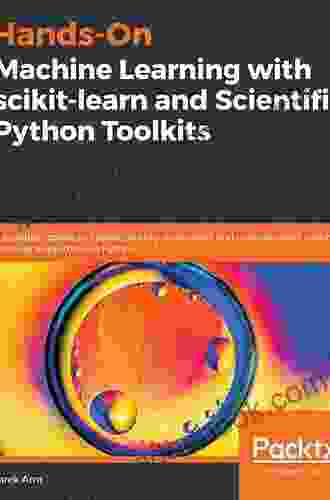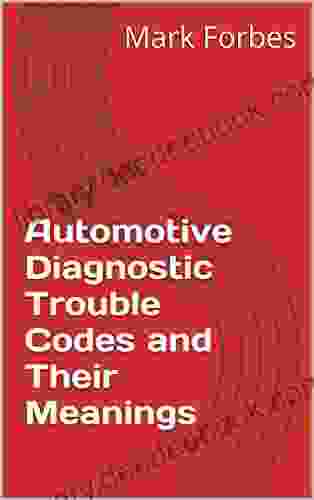Hands-On Machine Learning with Scikit-Learn and Scientific Python Toolkits

Machine learning (ML) has revolutionized various industries, from healthcare to finance to manufacturing. To harness its full potential, it's essential to have a solid foundation in ML principles and techniques. In this comprehensive guide, we'll embark on a hands-on journey of machine learning using Scikit-Learn, a powerful library for ML in Python.
4.7 out of 5
| Language | : | English |
| File size | : | 18083 KB |
| Text-to-Speech | : | Enabled |
| Enhanced typesetting | : | Enabled |
| Print length | : | 384 pages |
Getting Started with Scikit-Learn
Scikit-Learn is a user-friendly and comprehensive library that provides a wide range of tools for ML tasks. To get started, let's install Scikit-Learn using the following command:
pip install scikit-learn
Once installed, we can import the library as follows:
import sklearn
Supervised Learning
Supervised learning is a type of ML where we have labeled data and the goal is to learn a model that can predict the labels of new data. Some common supervised learning algorithms available in Scikit-Learn include:
- Linear Regression: Used for predicting continuous target variables.
- Logistic Regression: Used for predicting binary target variables.
- Decision Trees: Used for both classification and regression tasks.
- Support Vector Machines (SVMs): Used for classification tasks.
To demonstrate supervised learning with Scikit-Learn, let's use the Iris dataset, which consists of iris flower measurements and their species labels. We can load the dataset using the following code:
from sklearn.datasets import load_iris iris = load_iris()
We can then split the data into training and testing sets, train a model, and evaluate its performance as follows:
from sklearn.model_selection import train_test_split from sklearn.linear_model import LogisticRegression from sklearn.metrics import accuracy_score
X_train, X_test, y_train, y_test = train_test_split(iris.data, iris.target, test_size=0.2) model = LogisticRegression() model.fit(X_train, y_train) y_pred = model.predict(X_test) accuracy = accuracy_score(y_test, y_pred) print("Accuracy:", accuracy)
Unsupervised Learning
Unsupervised learning is a type of ML where we have unlabeled data and the goal is to identify patterns or structures within the data. Some common unsupervised learning algorithms available in Scikit-Learn include:
- Principal Component Analysis (PCA): Used for dimensionality reduction.
- K-Means Clustering: Used for grouping similar data points into clusters.
- Hierarchical Clustering: Used for creating a hierarchical structure of clusters.
To demonstrate unsupervised learning with Scikit-Learn, let's use the MNIST dataset, which consists of handwritten digits. We can load the dataset using the following code:
from sklearn.datasets import load_digits digits = load_digits()
We can then apply PCA to reduce the dimensionality of the data and visualize the results as follows:
from sklearn.decomposition import PCA import matplotlib.pyplot as plt
pca = PCA(n_components=2) reduced_digits = pca.fit_transform(digits.data) plt.scatter(reduced_digits[:, 0], reduced_digits[:, 1], c=digits.target) plt.colorbar() plt.show()
Feature Engineering
Feature engineering is the process of transforming raw data into features that are more suitable for ML models. It involves selecting informative features, removing irrelevant features, and creating new features that capture valuable information. Scikit-Learn provides various tools for feature engineering, including:
- StandardScaler: Used for scaling features to have zero mean and unit variance.
- MinMaxScaler: Used for scaling features to a range of [0, 1].
- OneHotEncoder: Used for encoding categorical features into binary vectors.
Model Evaluation
Evaluating the performance of ML models is crucial to assess their effectiveness and identify areas for improvement. Scikit-Learn offers a range of metrics for evaluating different types of ML models, including:
- Accuracy: For classification models, measures the proportion of correctly predicted labels.
- Mean Squared Error (MSE): For regression models, measures the average squared difference between predicted and actual values.
- F1-score: For classification models, combines precision and recall into a single metric.
These metrics can be used to compare different models and optimize their hyperparameters for better performance.
Case Studies
To illustrate the practical applications of machine learning with Scikit-Learn, let's explore a few case studies:
- Predicting Diabetes Risk: Using data from the Pima Indians Diabetes Database, we can train a logistic regression model to predict the risk of diabetes based on various medical measurements.
- Classifying Handwritten Digits: Using the MNIST dataset, we can train a support vector machine to classify handwritten digits with high accuracy.
- Customer Segmentation: Using data from a retail store, we can apply clustering algorithms to identify different customer segments based on their purchasing behavior.
This guide has provided a comprehensive to hands-on machine learning using Scikit-Learn and other scientific Python toolkits. By leveraging the power of Scikit-Learn, we can effectively tackle real-world ML problems, from supervised learning and unsupervised learning to feature engineering and model evaluation. Embracing machine learning with Scikit-Learn empowers us to make data-driven decisions and uncover valuable insights from complex data.
4.7 out of 5
| Language | : | English |
| File size | : | 18083 KB |
| Text-to-Speech | : | Enabled |
| Enhanced typesetting | : | Enabled |
| Print length | : | 384 pages |
Do you want to contribute by writing guest posts on this blog?
Please contact us and send us a resume of previous articles that you have written.
 Page
Page Chapter
Chapter Text
Text Genre
Genre Library
Library E-book
E-book Magazine
Magazine Bookmark
Bookmark Shelf
Shelf Bibliography
Bibliography Foreword
Foreword Preface
Preface Annotation
Annotation Footnote
Footnote Manuscript
Manuscript Tome
Tome Bestseller
Bestseller Narrative
Narrative Reference
Reference Encyclopedia
Encyclopedia Character
Character Resolution
Resolution Catalog
Catalog Stacks
Stacks Archives
Archives Study
Study Scholarly
Scholarly Reserve
Reserve Reading Room
Reading Room Rare Books
Rare Books Special Collections
Special Collections Literacy
Literacy Study Group
Study Group Thesis
Thesis Dissertation
Dissertation Storytelling
Storytelling Reading List
Reading List Book Club
Book Club Theory
Theory Textbooks
Textbooks Narendra Malhotra
Narendra Malhotra Judith Hicks Stiehm
Judith Hicks Stiehm Tom Miller
Tom Miller Fred Fanning
Fred Fanning David Spiller
David Spiller Len Sperry
Len Sperry Max Blumenthal
Max Blumenthal Nicholas Sparks
Nicholas Sparks Solomon Northup
Solomon Northup Jo Colwill
Jo Colwill Dorothy Parker
Dorothy Parker Brenda Woods
Brenda Woods Django Reinhardt
Django Reinhardt Rick Mattingly
Rick Mattingly Kerry Egan
Kerry Egan Massimiliano Salerno
Massimiliano Salerno Martin Alaimo
Martin Alaimo Stanley Vast
Stanley Vast Lynn Simone
Lynn Simone Taryn Souders
Taryn Souders
Light bulbAdvertise smarter! Our strategic ad space ensures maximum exposure. Reserve your spot today!
 Jamie BellFollow ·12.3k
Jamie BellFollow ·12.3k Russell MitchellFollow ·15.6k
Russell MitchellFollow ·15.6k Greg CoxFollow ·15.9k
Greg CoxFollow ·15.9k James JoyceFollow ·15.9k
James JoyceFollow ·15.9k Chandler WardFollow ·16.4k
Chandler WardFollow ·16.4k Jimmy ButlerFollow ·9.7k
Jimmy ButlerFollow ·9.7k George R.R. MartinFollow ·15.5k
George R.R. MartinFollow ·15.5k Virginia WoolfFollow ·18.8k
Virginia WoolfFollow ·18.8k

 Ralph Ellison
Ralph EllisonHealth Care Global Viewpoints: Samantha Whiskey
Samantha Whiskey is a global health...

 Gabriel Garcia Marquez
Gabriel Garcia MarquezTeacher Educators' Reflections on Culturally Relevant...
In today's...

 Levi Powell
Levi PowellSustainable Project Management: The GPM Reference Guide...
In today's rapidly changing world,...

 Isaac Bell
Isaac BellThe Captivating World of "Dreaming Awake Falling Under"
A Journey Through...

 Clarence Brooks
Clarence BrooksGovernance Regulations Valuations Mergers And...
In today's complex and ever-changing...
4.7 out of 5
| Language | : | English |
| File size | : | 18083 KB |
| Text-to-Speech | : | Enabled |
| Enhanced typesetting | : | Enabled |
| Print length | : | 384 pages |













